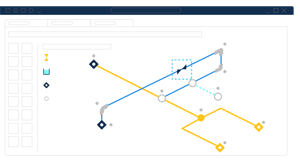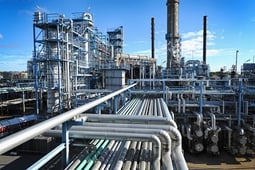
Solve challenging steam and gas transient problems
Accurately simulate how your steam and gas systems will respond to potentially disruptive transient events.









You need accuracy
Model shocks, reflections, choking, and heat transfer with a transient solver built for gas/steam upsets so pressures and temperatures are predicted that you can act on.
Simulate trips, valve/damper moves, and emergency shutdowns with timed or conditional events to verify procedures and interlocks before you run them in the plant.
Predict depressurization timelines, relief flows, and temperature drops to check allowable limits at headers, tie-ins, and downstream consumers.
Developed by Engineers, for Engineers
Compressible transient solver
Model pressure waves and shocks in gas and steam networks during startups, trips, and emergency actions.
- Method-of-Characteristics–based transient solution for compressible flow
- Tracks pressure, temperature, density, velocity, and Mach number over time
- Handles subsonic to choked flow and reflections at junctions and area changes
- Includes pipe/duct heat transfer with temperature-dependent properties

Equipment & valve transients
Capture real equipment and control behavior during operational events.
- Compressor transients with speed profiles and staging (start/stop, ramping)
- Time-dependent valve actions (Cv/Kv/K vs. time), regulators, and relief devices
- Simulate trips, restarts, damper moves, and ESD closures with event sequencing
- Check operating limits such as approach to choke, minimum flow, or surge margins

Blowdown, venting & ESD analysis
Evaluate depressurization and emergency sequences to protect assets and people.
- Model unit/header blowdowns, isolation steps, and relief/vent interactions
- Predict time histories for pressures, temperatures, and mass flow to stacks or headers
- Compare relief setpoints, vent paths, and equipment configurations across scenarios
- Verify allowable limits at tie-ins, branches, and downstream consumers

Workflow, visualization & data exchange
Build, compare, and communicate models efficiently.
- Scenario Manager to maintain alternatives in one file with inheritance and comparisons
- Time-history graphs, enveloping plots, animations, and color-mapped network results
- Excel import/export for model data and results handoff
- Layout imports from common piping/duct formats to accelerate model creation
- Color-mapped results to highlight bottlenecks, shocks, and choking
- Configurable reports and model snapshots for reviews and handoffs

Boundary conditions & controls
Represent real plant interfaces and the events that drive compressible transients.
- Pressure, mass flow, and temperature sources with schedules and ramps
- Time-varying restrictions (dampers, nozzles) and area changes
- User-defined events for trips, interlocks, and control sequences
- Enforce allowable limits (pressure, temperature, Mach) with design alerts

Fluids & property libraries
Use reliable thermophysical data for accurate compressible-transient results.
- Real-gas and ideal-gas options with temperature- and pressure-dependent properties
- Steam and common industrial gases available; add custom fluids and mixtures
- Define gas composition by mass or mole fraction for property calculations
- Set reference conditions and units consistently across the model

Pulsation frequency analysis (PFA Module)
Quantify pulsations and avoid acoustic resonance in gas/steam networks.
- Build an acoustic network model and compute natural frequencies and mode shapes
- Evaluate pulsation amplitudes versus acceptance limits across operating points
- Identify resonance risks at headers/branches and test mitigation options
- Size and place pulsation control devices (bottles, accumulators, chambers, orifices)
- Use spectral plots and envelopes to document compliance and compare designs

Datacor Pipe Flow Modeling is built for professionals who design, analyze, and operate complex fluid systems.
- Aerospace
- Biofuels
- Chemical Manufacturing
- Data Centers
- District Heating & Cooling
- Food & Beverage
- Manufacturing
- Oil & Gas
- Mining
- Pharmaceutical
- Power & Nuclear Power Generation
- Pulp & Paper
- Research and Development
- Water & Wastewater
Questions?
Does xStream handle sonic choking?
How is xStream different from Arrow?
Does xStream support real-gas behavior and heat transfer?
Can xStream model liquid waterhammer or two-phase flow?
What boundary conditions and events can I define?
How are valves, regulators, and relief devices modeled in transients?
What visualization and reporting does xStream offer?
How large can my model be, and what affects run time?
Pipe Flow Modeling Resources
Explore More Resources








You may also be interested in
Calculate steady-state hydraulic pressure drop and pipe flow distribution in liquid and low-velocity gas piping and ducting systems.
Determine the pressure drop and flow distribution, analyze sonic choking, and model real gases in steady-state gas and steam piping systems.
Analyze pumping systems for harmful pressure surge transients caused by water hammer
Robust chemical process simulation software designed to meet the diverse needs of engineers who design, troubleshoot, and innovate.